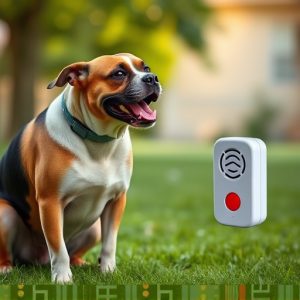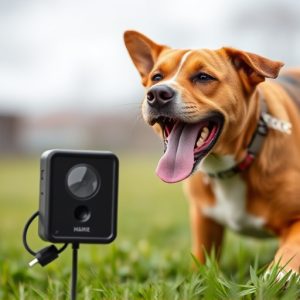Sonic Solutions: Train Dogs, Calm Neighborhoods with Anti-Barking Devices
In densely populated areas, excessive dog barking disrupts communities. Anti-barking devices like so…….
In densely populated areas, excessive dog barking disrupts communities. Anti-barking devices like sonic deterrents offer a humane solution. These tools emit inaudible high-frequency sounds (up to 40,000 Hz) that stop dogs from barking without disturbing humans. Sonic deterrents promote positive behavior modification through rewards for quietness, reducing noise and fostering harmonious neighborhoods. They are effective, portable, and ideal for large areas or close-knit communities already using similar devices. Selection requires understanding neighborhood dynamics, and strategic planning & education ensure responsible use for a peaceful environment.
In many neighborhoods, dog barking can be a persistent and disturbing issue, affecting quality of life and community harmony. This article explores an innovative solution: anti-barking devices, specifically focusing on sonic deterrents designed for canine behavior modification. We’ll delve into the science behind these tools, their benefits, and how to choose the right one for your area. Additionally, we provide guidance on implementation and training to ensure effective use of this modern approach to managing neighborhood noise.
- Understanding Dog Barking and Its Impact on Neighborhoods
- The Science Behind Sonic Deterrents for Dogs
- Advantages of Using a Sonic Deterrent Range for Dogs
- How to Choose the Right Anti-Barking Device for Your Area
- Implementation and Training: Ensuring Effective Use
Understanding Dog Barking and Its Impact on Neighborhoods
Dog barking is a natural form of communication for canines, serving as a way to express excitement, warn of potential dangers, or simply assert their presence. However, when left unchecked, excessive barking can disrupt neighborhoods and cause discomfort among residents. In densely populated areas, where homes are close together, the constant chatter of dogs can be a significant source of noise pollution, leading to community tensions.
Anti-barking devices, such as sonic deterrents designed for dogs, offer a solution to mitigate these issues. These tools operate within a specific sonic deterrent range for dogs, emitting high-frequency sounds that are inaudible to humans but have been shown to effectively stop barking when triggered by the animal’s vocalizations. By utilizing this technology, residents can enjoy quieter environments while still respecting their canine neighbors’ needs.
The Science Behind Sonic Deterrents for Dogs
The Science Behind Sonic Deterrents for Dogs
Sonic deterrents for dogs operate on the principle of using high-frequency sound waves to disrupt and discourage unwanted behavior, specifically excessive barking. This technology leverages the fact that dogs have a far greater range of hearing than humans, with some breeds being able to detect sounds up to 40,000 Hz or more. Traditional noise deterrents emit random, high-pitched noises that can startle dogs without causing them harm. These sounds are often in the ultrasonic range (above 25,000 Hz), making them inaudible to human ears but effective at capturing a dog’s attention and modifying their behavior.
The effectiveness of sonic deterrents comes from their ability to target specific behaviors while minimizing distress to the animals. Unlike shock collars, which use electric impulses, these devices promote positive reinforcement by rewarding quiet behavior. When a dog barks excessively, the device activates, emitting an unpleasant but non-harmful sound that quickly catches the animal’s attention. Over time, dogs learn to associate barking with this annoyance, leading to a significant reduction in unwanted noise. This approach not only helps maintain peace within neighborhoods but also fosters a more harmonious relationship between humans and their canine companions.
Advantages of Using a Sonic Deterrent Range for Dogs
Using a sonic deterrent range for dogs offers several advantages over traditional methods of addressing excessive barking. Unlike shock collars or loud noise machines, which can be stressful and potentially harmful to canines, sonic deterrents emit high-frequency sound waves that are inaudible to humans but irritating to dogs. This humane approach not only reduces barking without causing physical pain but also helps build a positive training environment.
Additionally, sonic deterrents are effective for long-term use as they teach dogs to associate certain areas or behaviors with the unpleasant sensation caused by the sound waves. They can be easily transported and used in various settings, making them ideal for neighborhoods where barking is a persistent issue. Moreover, these devices can cover a wide range of areas, ensuring that multiple dogs within a neighborhood can be trained simultaneously, leading to quieter and more harmonious living spaces.
How to Choose the Right Anti-Barking Device for Your Area
When selecting an anti-barking device, understanding your neighborhood dynamics is key. Different areas have varying levels of noise tolerance and dog populations, so choosing a device that fits your specific needs is crucial. Consider the size of your area; larger yards or open spaces may require a more powerful sonic deterrent range for dogs to be effective.
Additionally, think about the nearby homes and their preferences. Some neighborhoods might prefer quieter solutions, while others may already have similar devices in use. Selecting an anti-barking tool that complements existing measures and respects community preferences ensures a harmonious environment for all residents, including furry neighbors.
Implementation and Training: Ensuring Effective Use
Implementing an anti-barking device requires careful planning and training to ensure its effective use within a neighborhood setting. The Sonic Deterrent Range for Dogs is a popular solution, utilizing high-frequency sound waves that are inaudible to humans but disruptive to dogs. Before deployment, residents should attend training sessions to understand how the device operates, when to activate it, and how to respond if necessary. Proper training can foster a sense of collective responsibility, ensuring the device is used responsibly and only when excessive barking occurs.
During the training process, it’s crucial to educate neighbors about the device’s range and effectiveness. The Sonic Deterrent Range for Dogs typically covers several hundred feet, so defining clear boundaries where the device will be active can help prevent unnecessary activation. By understanding their role in this collective effort, residents are more likely to adhere to guidelines, resulting in a quieter and more harmonious living environment for all.
The sonic deterrent range for dogs offers a peaceful solution to neighborhood disputes caused by excessive barking. By understanding canine behavior and leveraging scientific principles, these devices provide an effective and humane way to train dogs without causing harm. When choosing the right anti-barking device, considering your area’s unique needs is key. With proper implementation and training, sonic deterrents can foster a quieter, more harmonious environment for all residents, ensuring everyone can enjoy their peaceful surroundings.


